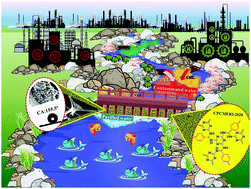The designed synthesis of a hydrophobic covalent polymer composite to expel toxic dyes and oil from wastewater: theoretical corroboration†
Abstract
In pursuit of addressing a global issue linked to the purification of contaminated water bodies, a hitherto less-explored hydrophobic melamine–terephthalaldehyde cross-linked covalent organic framework (COF) (named CPCMERI-2020) and its post-synthetically modified composites CPWCS (a composite of waste carbon soot particles (WCS) and CPCMERI-2020) and MS@CPWCS (CPWCS-coated melamine sponge (MS)) are reported herein. MS@CPWCS showed exceptional superhydrophobicity with a water contact angle of about 155.4 ± 0.3° owing to: (a) π–π stacking between the covalent framework and carbon soot; and (b) the presence of a high number of conjugated electron-rich organic entities. The hydrophobicity, together with the oleophilicity, made this composite, MS@CPWCS, an excellent contender to separate several toxic organic solvents and petroleum oil elements at an absorption capacity of 70-150 mg g−1 from adulterated water bodies. In addition to this, CPCMERI-2020 shows excellent absorptivity towards three cationic dyes: rhodamine-B (450 mg g−1), malachite green (350 mg g−1), and methylene blue (255 mg g−1), which makes this work unprecedented; furthermore, this work explores a new avenue of research in the multifaceted-materials-based field of water purification.



 Please wait while we load your content...
Please wait while we load your content...